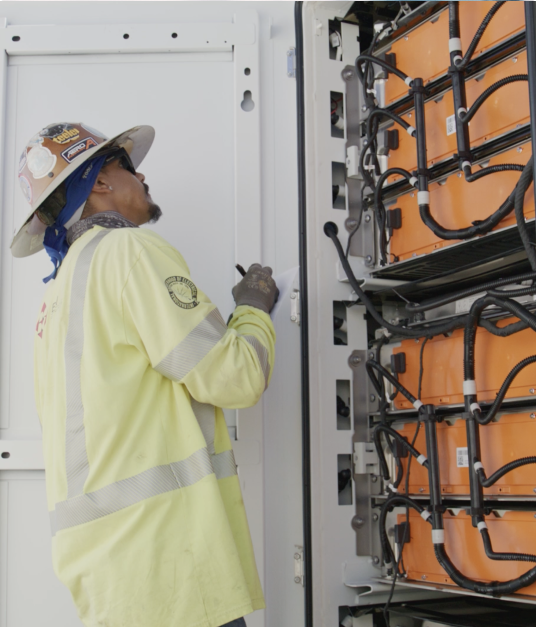
Battery Energy Storage, Explained
Energy storage powers our daily lives. The same technology that charges our phones, laptops, and electric vehicles is now making our electric grid more reliable. It enables our homes, businesses, and transportation infrastructure to run on clean, affordable electricity.
Flexibility for our power system, benefits for us all.
Energy storage systems provide flexibility to our electric infrastructure, producing a number of benefits:


Bolstering a clean electricity system
Energy storage enables electricity to be saved and used at a later time, when and where it is most needed. That unique flexibility enables power grid operators to rely on much higher amounts of variable, clean sources of electricity, like solar, wind, and hydropower, and to reduce our dependence on fuel-based generation, like coal and gas. Delivering more clean electricity with energy storage reduces local air pollution and greenhouse gas emissions from our power system.
Reducing cost
By storing energy when the price of electricity is low and discharging that energy later during periods of expensive, high demand, energy storage reduces the cost of power. When passed through to customers, those efficiencies can save families and businesses money.
Enhancing resilience
Similar to back-up batteries for household devices, energy storage systems support the larger electrical grid during extreme weather events and other disruptions. Keeping the lights on, air-conditioning or heating systems operating, and critical infrastructure working is important to keeping people safe.
Supporting local economies
Energy storage projects provide local taxes where they are sited, boosting local economies without adding pressure on other governmental services.
Did you know?
Facts about energy storage.
Safety is our #1 priority.
GridStor is committed to the safety of our employees, contractors, partners and neighbors.


Held to the highest safety standards
The safe operation of our battery energy storage facilities is essential to providing the stable electric supply that powers ever more of our economy.
Rigorous codes and standards
Our energy storage projects must meet rigorous codes and standards to be permitted to operate – just like every other part of the electric system.
Certified batteries
Every battery that we integrate with the electric grid is certified and tested to meet current safety standards.
National fire protection standards
Every energy storage project we build meets or exceeds national fire protection standards. These standards are frequently updated to incorporate the codes and industry best practices for hazard mitigation tools and strategies.
Local and regional collaboration
We collaborate with state and local governments to plan, construct, and operate each project with safety as a top priority, in compliance with their current standards.
How we practice energy storage safety.
At every stage, from planning to engineering to construction and operation, GridStor implements diversified strategies to ensure the safety of our battery energy storage facilities.
Engineering standards and testing
The batteries our projects use are designed, manufactured, and tested to adhere with the highest safety standards. The battery equipment must pass large-scale fire testing under Underwriters Laboratories certification.
Proper temperature management
Our energy storage projects have thermal management systems including ventilation, heating equipment, and cooling equipment, to maintain safe operating temperatures and humidity for the batteries.
Battery health sensors
Our projects are equipped with sensors that monitor battery voltage, current, temperatures and health to ensure early detection and mitigation of issues.
Fire safety equipment
Our energy storage facilities include equipment and systems designed to detect thermal events, vent gasses, and mitigate propagation of any fire or thermal event.
Local training
We provide site-specific information and training to local fire departments and first responders to ensure an appropriate response to any project emergency.
24/7 monitoring by trained personnel
Our energy storage facilities are monitored 24/7 by trained personnel prepared to maintain safety and respond to emergency events.
Protected access
We only permit authorized personnel to access our facilities, just as a local utility would for its facilities.
Emergency response plans
We develop, maintain, and train using a project-specific emergency response plan to ensure that, if there were an emergency, it is handled safely and according to best practices.
Storing electricity for when it’s needed most.
America’s electric system is in the midst of a technological transformation. Infrastructure and generation built before the computer age is retiring. Zero-emissions power sources are being built at unprecedented scale, replacing fossil fueled generation. Transportation and industrial sectors are swapping fuels for electricity. And battery storage technology provides the flexibility that makes it all work reliably and affordably.


The path to decarbonization is paved with batteries
Energy storage is essential for a power system that relies on zero-emissions energy sources.
Flexible
When charged during periods of excess solar, wind, or hydropower generation and discharged at times of high demand otherwise served by fuel-based generation, energy storage maximizes the use of renewable energy and reduces the carbon intensity of the power system. As storage provides more flexibility to the power system, fuel-based resources can also run less frequently and more efficiently, reducing emissions further.
Responsive
Batteries are the fastest resource on the grid, providing electricity instantaneously in response to sudden changes in demand or disruptions to supply. In a future with more renewables and increasingly extreme weather, quick ramping from storage will ensure continuity of service.
Building a world where every community has clean energy around the clock.
GridStor builds and operates batteries on the American power grid storing electricity to deliver when and where it is most needed.


